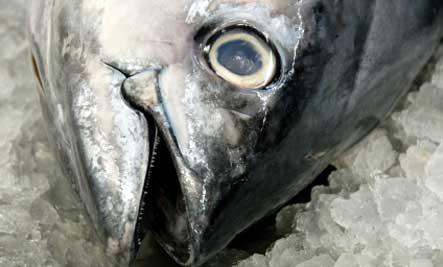Let us put aside ideology — for a moment — and instead state an unadorned bit of common sense: Bluefin tuna (and other large fish) would not be in danger if humans did not kill and eat them. Thus, in that spirit, here are 8 Reasons Why We Should Leave Tuna (and Other Large Fish) Alone.
The FDA says: “Nearly all fish and shellfish contain traces of methylmercury. However, larger fish that have lived longer have the highest levels of methylmercury because they have had more time to accumulate it.” What can methylmercury do to us humans? For starters: brain damage, memory loss, personality change, tremours, spontaneous abortion, and damage to a developing foetus. Fatigue and memory loss caused by mercury poisoning from eating fish is so common that doctors even have a name for it: fish fog.
2. Large Fish Are Just Like Kittens (or Maybe Even Tigers)
In the words of PETA’s Ashley Byrne: “PETA thought that by renaming fish sea kittens, compassionate people who would never dream of hurting a dog or a cat might extend that sympathy to fish, or sea kittens.” Why kittens? Well, like cats, fish feel pain, have complex social interactions, form bonds, and express affection by gently rubbing against one another. You would not hook a cuddly little kitty through the mouth, would you? Greenpeace is taking a different approach, characterizing eating the endangered fish like eating a rhino or tiger. I think I prefer the kittens.
3. Tuna Deserve Respect, Not Extinction
Tuna are migratory fish that travel many thousands of kilometres in their lifetimes – swimming more than 160 kilometres in a day. They can accelerate faster than a Porsche and reach speeds as high as 80 kilometres per hour.
4. Save the Dolphins and Whales
“Tuna is about as ‘dolphin-friendly’ as a boat propeller,” say the folks at PETA. “Even if dolphins aren’t ‘accidentally’ trapped in tuna nets, they are still killed intentionally by Japanese tuna anglers because they prey on tuna. Entire pods of whales and dolphins are rounded up and driven into shallow water where all but the youngest (who are captured and sold to aquariums) are slaughtered with knives and machetes.”
5. Eating Tuna Creates a Large Carbon Footprint
“Once caught,” writes Matthew McDermott, “the fish are packed into refrigerated coffins and flown to auction in Tokyo, where they are bought for up to $100,000 per tuna (bluefin are quite large…). From there, if not consumed locally, they are flown again around the world for sale in the United States, Europe or China.”
6. Overfishing is Killing Our Oceans
Greenpeace explains: “Populations of top predators, a key indicator of ecosystem health, are disappearing at a frightening rate, and 90 percent of the large fish that many of us love to eat, such as tuna, swordfish, marlin, cod, halibut, skate, and flounder have been fished out since large scale industrial fishing began in the 1950s.”
7. Food Poisoning
Every year, there are roughly 75 million cases of food-borne illness reported in the U.S. (not including, of course, episodes mistakenly attributed to stomach flu or virus). This leads to hundreds of thousands of hospitalizations and thousands of deaths. No surprises for all as the number one cause of food poisoning in the U.S. is seafood.
8. Why Eat Dead Fish?
Why disrupt marine eco-systems by killing tens of thousands of creatures we humans do not even need to eat when you can choose a vegan tuna melt or vegan tuna burger or even some raw vegan tuna salad?
Selected and curated from Planet Green




